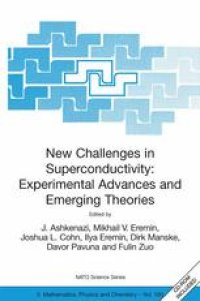
Ebook: New Challenges in Superconductivity: Experimental Advances and Emerging Theories: Proceedings of the NATO Advanced Research Workshop on New Challenges in Superconductivity: Experimental Advances and Emerging Theories Miami, Florida, U.S.A. 11–14 January 2
- Tags: Science general, Physics general, Condensed Matter, Solid State Physics and Spectroscopy, Superconductivity Superfluidity Quantum Fluids
- Series: NATO Science Series 183
- Year: 2005
- Publisher: Springer Netherlands
- Edition: 1
- Language: English
- pdf
This volume contains the proceedings of the 2004 University of Miami Workshop on Unconventional Superconductivity. The workshop was the fourth in a series of successful meetings on High-T Superconductivity and C related topics, which took place at the James L. Knight Physics Building on the University of Miami campus in Coral Gables, Florida, in January 1991, 1995, 1999, and 2004. The workshop consisted of two consecutive events: 1. NATO Advanced Research Workshop (ARW) on New Challenges in Superconductivity: Experimental Advances and Emerging Theories, held on January 11-14, 2004; 2. Symposium on Emerging Mechanisms for High Temperature Superconductivity (SEMHTS), held on January 15-16, 2004. It is hard to write a balanced preface to a volume like this one, yet at least we try to offer the reader a taste of what was happening in this workshop. There were close to a hundred scientists from around the world, albeit fewer Russians than we had originally hoped for. Nevertheless, the workshop was very lively and we trust that this is demonstrated in this volume. The workshop included high-quality presentations on state of the art works, yet a key issue, discussed by many, was how homogeneous the cuprates are. STM data, as well as other reports, showed that the cuprate superconductors (SC’s) studied were inhomogeneous, especially in the underdoped regime; while experiments, like ARPES and magnetoresistance have established the existence of a Fermi Surface (FS), at least above some doping level, in the cuprates.
This volume contains the proceedings of the 2004 University of Miami Workshop on Unconventional Superconductivity. The workshop was the fourth in a series of successful meetings on High-TC Superconductivity and related topics, which took place at the James L. Knight Physics Building on the University of Miami campus in Coral Gables, Florida, in January 1991, 1995, 1999, and 2004.
The volume includes high-quality papers on state of the art works on unconventional superconductivity. A key issue, discussed by many in the workshop, was how homogeneous the cuprates are. STM data, as well as other reports, showed that the cuprate superconductors (SC's) studied were inhomogeneous, especially in the underdoped regime; while experiments, like ARPES and magnetoresistance have established the existence of a Fermi Surface, at least above some doping level, in the cuprates.
Other topics ranging from the pseudogap problem to pairing mechanisms are also discussed by various authors. In general, experiments show more convergence than high-TC theories. There is definitely no consensus on the high- TC mechanism, although two broad groups exist: those around the extended "Big Tent" homogenous scheme, and those who assume an intrinsic inhomogeneous state. Another division could be viewed between those who consider the high- TC mechanism to be essentially of an electronic-magnetic origin (with no role played by the lattice), and those who assign an important role to the lattice.
There seemed to be a consensus in the workshop that MgB2 and the fullerenes are simpler SC's than the cuprates, while work on ruthenocuprates and the coexistence of SC and ferromagnetism provided new stimuli to research and understanding. Interest was drawn also by the new NaxCoO2•yH2O SC. Although this is a low-TC material, its physical properties have a similarity to those of the cuprates; thus research on this system seems to be important for the understanding of high TC SC.
The volume gives a brief overview of many facets of present day superconductivity research and should be of great interest to all scientists and research students who work in the field of superconductivity or related subjects in condensed matter physics and material sciences.